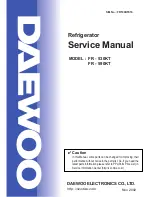
EN -10-
CHAPTER -6: TROUBLESHOOTING
•
There is no dust on the condenser ,
•
There is enough place at the rear and side walls.
If your fridge is operating too loudly;
To maintain the set cooling level, compressor may be activated from time to time. Noises from your fridge at this time
are normal and due to its function. When the required cooling level is reached, noises will be decreased automatically.
If the noises persist;
•
Is your appliance stable? Are the legs adjusted?
•
Is there anything behind your fridge?
• Are the shelves or dishes on the shelves vibrating? Re-place the shelves and/or dishes if this is the case.
•
Are the items placed on your fridge vibrating?
Normal Noises;
Short cracking:
Heard when the thermostat switches the compressor on/off.
Compressor noise (Normal motor noise):
This noise means that the compressor operates normally Compressor
may cause more noise for a short time when it is activated.
Bubbling noise and splash:
This noise is caused by the flow of the refrigerant in the tubes of the system.
Water flow noise:
Normal flow noise of water flowing to the evaporation container during defrosting. This noise
can be heard during defrosting.
Air Blowing Noise (Normal fan noise):
This noise can be heard in No-Frost fridge during normal operation of
the system due to the circulation of air.
If humidity builds up inside the cooler;
•
Are all food packed properly? Are the containers dried before placing them in the fridge?
•
Is the ridge door opened frequently? Humidity of the room gets in the fridge when the doors are opened.
Humidity build up will be faster when you open the doors more frequently, especially if the humidity of the room
is high.
•
Building up of water drops on the rear wall after automatic defrosting is normal. (in Static Models)
If the door is not opened and closed properly;
•
Do the food packages prevent closing of the door?
•
Are the door compartments, shelves and drawers placed properly?
•
Are door joints broken or torn?
•
Is your fridge on a level surface?
Recommendations
•
In instances of a power cut unplug the appliance. This prevents damage to the compressor. You should delay
plugging in 5 – 10 minutes after you regain power supply. This will avoid damage to components.
•
The cooling unit of your refrigerator is hidden in the rear wall. Therefore, water droplets or ice may occur on the
rear surface of your fridge due to the operation of the compressor in specified intervals. This is normal. There
is no need to perform a defrosting operation unless the ice is excessive.
•
If you will not use your fridge for a long time (e.g. in summer holidays) unplug it. Clean your fridge according to
chapter cleaning and leave the door open to prevent humidity and smell.
•
If the problem persists after you have followed all the instructions above, please consult an authorised service
provider.
CHAPTER -7: TIPS FOR SAVING ENERGY
1.
Always allow foodstuffs to cool before storing in the appliance.
2. Thaw food in the fridge compartment, this helps save energy.
Summary of Contents for SJ-LC11CTXIF-EU
Page 131: ......
Page 132: ...Service Support Visit Our Website sharphomeappliances com 52321092 ...












































